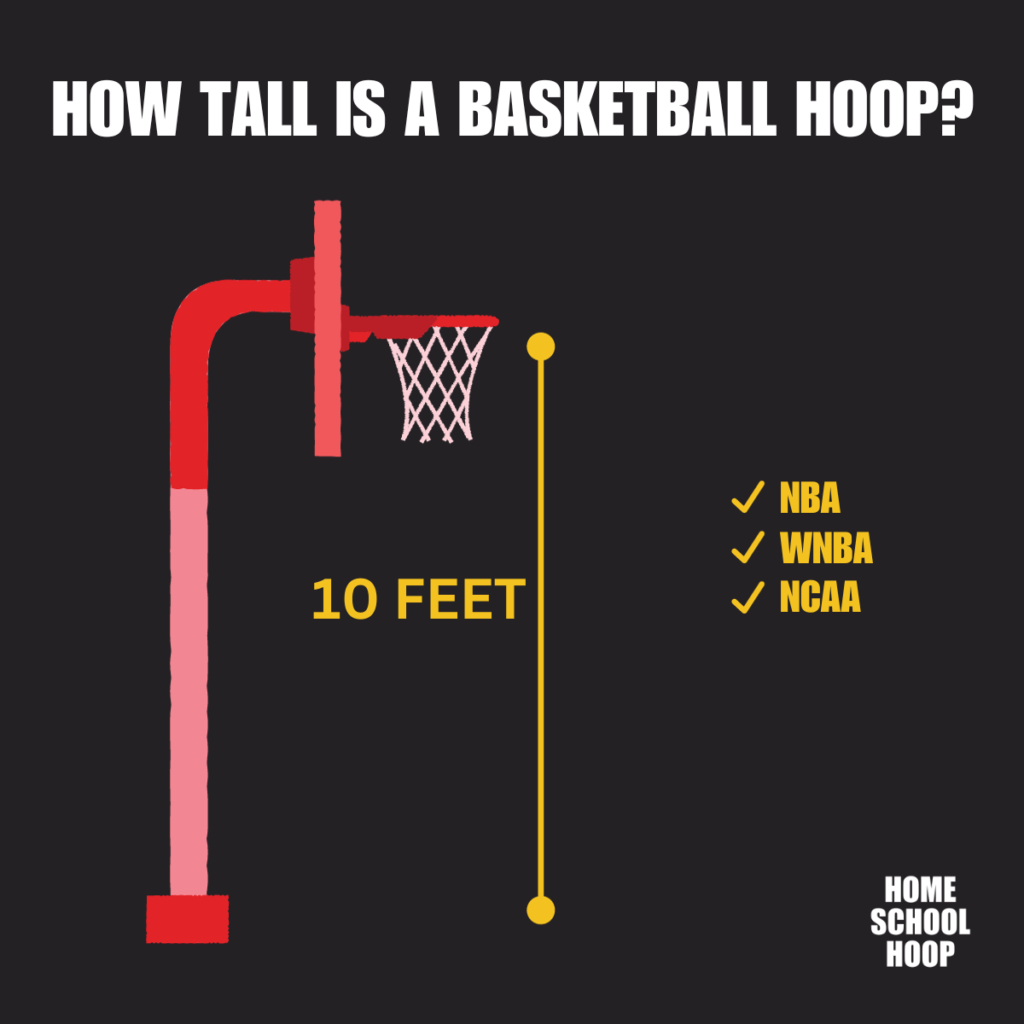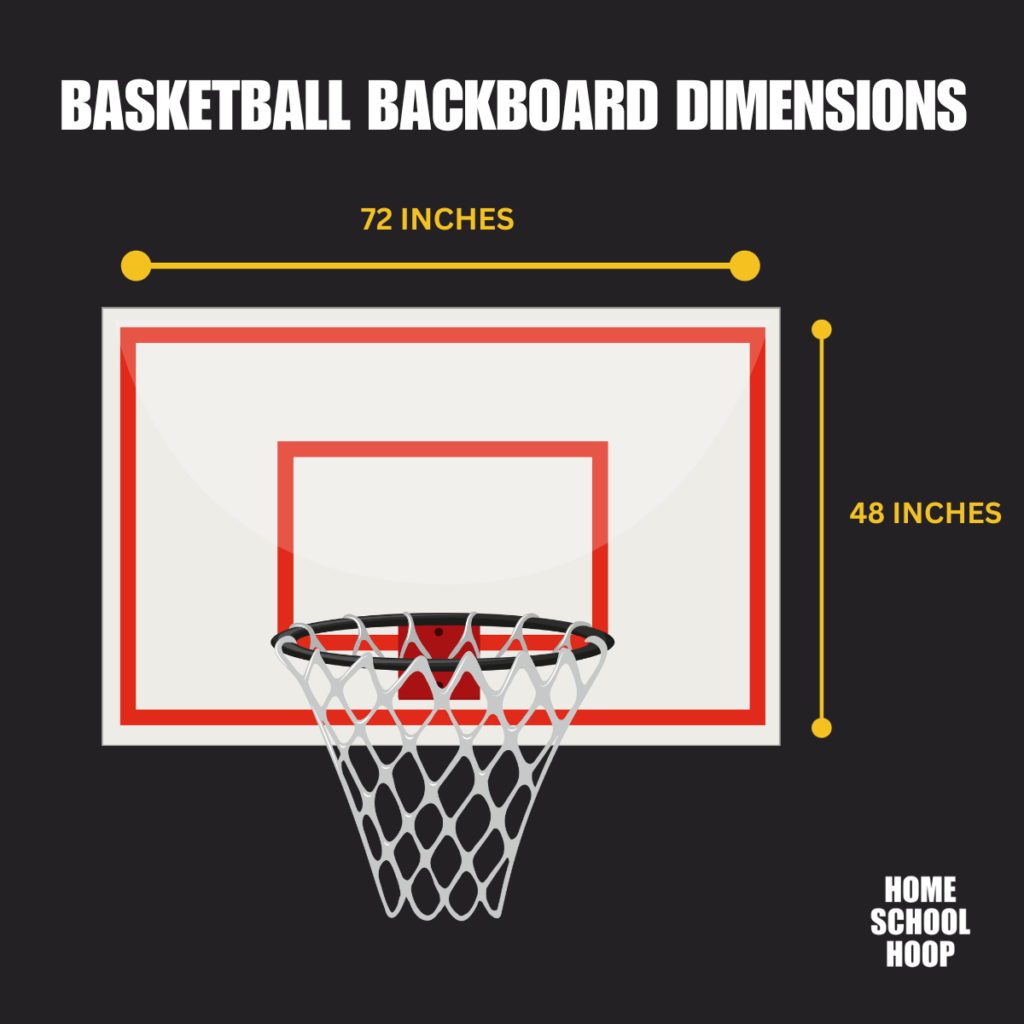Key takeaways:
- The standard height of both NBA and WNBA basketball hoops is 10 feet (3.05 meters).
- The 10-foot NBA and WNBA hoop height comes from basketball inventor James Naismith.
- The heights of some hoops you find at parks and schools are usually 10 feet but may be unpredictable.
Long-time hoopers can step up to a basketball hoop and immediately tell if it’s set to the correct height. More often than not, basketball hoops are the same height, which is important for players trying to become great shooters.
Despite the fair share of myths and misconceptions, the NBA, WNBA, and NCAA colleges all use the same hoop height. Some believe the WNBA uses a shorter hoop (come on, y’all!), while others are unsure of the exact measurements.
So, let’s break it down. In this article, we’ll look at the world of sizes and heights of basketball hoops, shedding light on the truths and debunking those frustrating myths. Whether you’re a curious fan or looking to set up your court, we have the answers you’re searching for.
The Standard Height of a Basketball Hoop

“How tall is a basketball hoop?” It’s a seemingly straightforward question, but the answer carries a long history.
The universally accepted height for a basketball hoop, used by organizations like the NBA, WNBA, and NCAA, is 10 feet (3.05 meters).
This measurement has remained unchanged since the dawn of basketball and can be traced back to the sport’s very creation by Dr. James Naismith in 1891.
Components of a Basketball Hoop
The basketball hoop isn’t just about the size of the pole and the net; the backboard and rim play pivotal roles in scoring dynamics.
How Big is a Basketball Backboard?

While there’s nothing like the sound of a swish, the backboard can’t be overlooked. The backboard is the large, flat board behind the rim.
The primary purpose of a backboard is to assist players in making bank shots (don’t forget to call the bank!). It also provides an additional rebounding surface for missed shots.
According to official regulations set by organizations like the NBA, WNBA, and NCAA, a standard basketball backboard measures 72 inches wide and 48 inches tall.
Backboards almost always have an inner rectangle painted in usually white or red, a visual aid for bank shots. This inner rectangle is 24 inches wide and 18 inches tall.
How Big is a Basketball Rim?
The rim, known more often as the “hoop,” is the circular metal ring players aim to shoot the ball through. For a field goal to count, the basketball needs to pass through the rim and the net attached below it.
The standard diameter of a basketball rim is 18 inches.
The rim size strikes a nice balance between challenge and achievability. Skilled shooters can certainly hit shots, yet it’s still relatively difficult to do so under pressure.
Why are Basketball Hoops 10 Feet Tall?
So, we’ve established that a basketball hoop stands 10 feet tall. But have you ever wondered why?
When Dr. James Naismith was in the early stages of creating the game of basketball, he needed a target for players to aim at. He was in a gymnasium that had a balcony, and he attached the rim to it. This balcony happened to be 10 feet off the ground.
Over time, while the game has evolved, that 10-foot measurement remained the standard. And it’s worked out because the hoop height is tall enough to require skill and precision but not too high that making shots is impossible.
The 10-foot rim also makes dunking possible for those with the right height, skill, and explosiveness combo. In the NBA and men’s NCAA basketball, dunking is common. You’ll also find some women’s NCAA and WNBA dunks, but they’re far less common.
Learn more: Who is the tallest NBA player?
Different Hoop Heights for Different Ages
Basketball hoop heights aren’t a one-size-fits-all scenario. While the regulation height at the college and professional level is 10 feet, it can be too tall for kids who lack the strength to reach the basket. So, younger players often use shorter hoops to develop their skills. For instance:
- Children ages 7 to 8 typically play on 8-foot hoops. You’ve seen young kids try to heave a ball toward a regulation rim. An 8-foot hoop is more manageable for their size, so they can focus on building fundamental skills like shooting and layups without the intimidation of a towering hoop.
- Kids between the ages of 9 to 11 use 9-foot hoops. As kids grow and their skills progress, so does the height of the hoop. This slightly taller target challenges them just enough.
- By the age of 12 or 13, players transition to the standard 10-foot hoop. This bump to a regulation hoop around middle school age gets kids ready to meet those high school standards and sets the stage for potential future endeavors at the college level.
WNBA Hoop Height: Debunking Myths
The WNBA hoop height is a topic that, for some reason, has been hit with countless myths and misconceptions. Let’s set the record straight about the WNBA rim height:
The hoop height in the WNBA is the same as in the NBA, standing at 10 feet.
Even so, whispers and rumors about a WNBA lower rim persist, leading to confusion. And in our mind, it undermines the talent and skill of the WNBA’s athletes.
So, what’s up with this myth of a shorter hoop in the WNBA? Part of it likely stems from societal biases or misunderstandings about women’s sports. Some might assume that the league would adjust the hoop height because the average WNBA height is lower than that of the NBA. But, this assumption is not true.
From its inception in 1996, the WNBA has maintained the standard 10-foot hoop. Next time you hear someone mention the WNBA lower rim, do us a favor and correct them!
Should the WNBA Use a Lower Rim Height?
The debate around women’s basketball hoop height is not new. UCONN coach Geno Auriemma floated the idea in 2012. Over the years, there have been suggestions about possibly lowering the rims in the WNBA to facilitate more dunks and to make the game more “exciting.”
But is this a change that truly benefits the sport? In our mind, the broader implications suggest it’s not a viable solution.
Here’s where both sides are coming from:
Pros of lowering the rim:
- Increased dunking opportunities: A lower rim would undeniably make it easier for more players to dunk, potentially adding a new dimension to the game. Right now, even the tallest WNBA players rarely dunk.
- Potential for new game strategies: With dunks in more players’ arsenal, teams could develop new offensive and defensive strategies, prompting the game to evolve.
- Shooting percentage may go up: With a lower rim, there would likely be fewer missed layups and more tip-ins, arguably speeding the game up and making it more exciting.
Cons of lowering the rim:
- Logistical challenges: Most basketball courts, from parks to high schools and colleges, feature 10-foot rims. Adjusting the height for the WNBA would create a disparity, making it challenging for young girls and college women to find appropriate hoops to practice on.
- Undermines the W: Lowering the rims could inadvertently diminish the achievements of WNBA players, suggesting they need assistance to play the game. Players spend years, if not decades, refining techniques to meet the demands of the regulation height.
- Financial implications: Given the already existing disparities in funding and prioritizing women’s sports, it’s not likely that parks and schools would invest in updating their courts to feature both rim heights.
When Shaquille O’Neal suggested it on TNT’s NBA Postgame Show, Candace Parker firmly opposed the idea of lowering the WNBA rim. She emphasized appreciating the game as it is.
Elena Delle Donne likes the idea because she believes more dunks would make games more exciting, but she also pointed out the broader implications and the challenges it would pose for younger players looking to hone their skills.
Lowering the WNBA hoop height might appeal to some, but more WNBA dunks would only invite criticism and comparisons to NBA dunks. Those who can’t appreciate the league as it is wouldn’t likely be convinced with a lower rim.
Challenges of the Regulation Height
The 10-foot basketball hoop isn’t a problem for the pros but undoubtedly presents challenges to younger or recreational players.
- Reaching the rim: The 10-foot hoop requires some major hops for any player interested in dunking. Taller players have an advantage in starting closer to the rim, but elevating to the rim requires some explosive power and natural athleticism that only some have. And despite the myth, it’s not true that playing basketball makes you taller.
- Shooting endurance: Continuously shooting at a 10-foot hoop requires more stamina and strength than would be needed if the rim were lower. Fatigue can set in, making maintaining proper shooting form and accuracy hard. That’s why great shooters practice at game speed while tired.
- Rebounding: Getting up for rebounds after a ball bounced off a 10-foot rim requires some physical prowess. Plus, anticipation and positioning.
Learn more: What is a rebound in basketball?
Unconventional Hoop Heights
Out in the world, you may come across unconventional hoop heights of varying heights that don’t adhere to the 10-foot standard.
Anyone who’s wandered through parks or playgrounds has come across different-sized hoops. These can be due to wear and tear (someone hanging on the rim too long?), poor installations, or deliberate adjustments for younger players.
Some slam dunk contests may take place on smaller hoops. While most use standard hoops, some novelty events or local contests might lower the rim for more dramatic dunks.
Other events might adjust the hoop height to make the game more accessible or entertaining. Celebrity or charity games, children’s events or camps, and experimental leagues are some examples that could try out different hoop heights.
FAQ
How tall is a real NBA hoop?
The official height of a real NBA hoop is 10 feet (3.05 meters).
Are WNBA hoops lower?
No – WNBA players play on a regulation 10-foot rim like NBA players and all collegiate players do.
Are park rims 10 feet?
Basketball hoops at parks, gyms, and other public recreational areas are almost always 10 feet tall. In rare cases, parks may have shorter hoops for children to play on.
How tall is a basketball hoop in inches?
A standard 10-foot tall basketball hoop is equal to a height of 120 inches (10 feet x 12 inches per foot = 120 inches).

